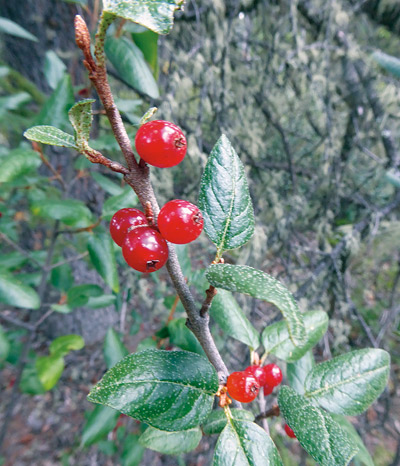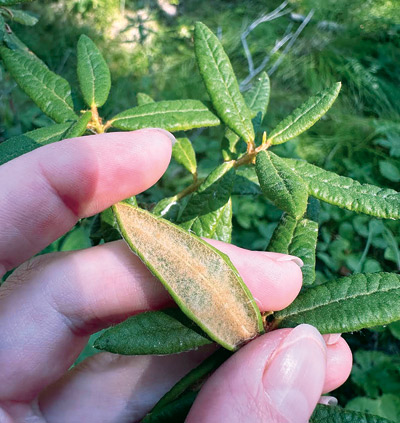Fall Foraging

Fall Foraging
by Melanie Patchell
Plants have spent all summer preparing a bounty: berries, nuts, and flavourful leaves. Bright clusters of juicy berries hanging from branches and peeking from under leaves are hard to miss! There are many species that ripen at the end of summer, and even become sweeter after a frost. Hazelnuts are nutritious and tasty if you know where to look and can beat the squirrels to them. Fall is a great time to harvest leaves for tea. It is easy to pick a few leaves from a plant here and there and end up with an interesting mix to enjoy as an herbal infusion at the end of the day.
Foraging is often the companion activity to other outdoor adventures, so keep a bag handy to take advantage of small, unexpected harvests that you might encounter. Know what to look for, and be ready to come back with a bucket.
I’ve included a description of some of my favourite harvests to look for this fall.

Choke Cherry (Prunus virginiana)
These luscious berries make one of the best jellies in the boreal, although they have a bad reputation: the clusters of dark purple cherries have a large seed and are far too astringent to be enjoyed fresh. They are not poisonous, however, and they are worth sampling fresh once in a while to really appreciate the name ‘choke’ cherry given to them by disgruntled foragers.

A trip to fill our buckets at a good choke cherry spot is one of our most anticipated harvests. Choke cherry bushes are widespread in Alberta, but the best spots for picking are where bushes form thickets on sunny hillsides. Plants are most conspicuous when fruits start to ripen in August. Each tiny cherry is such a dark purple that it appears almost black when ripe, and fruits are carried in dangling clusters that are easy to pick with one hand. The harvest season is forgiving, too, and berries can be harvested over a span of several weeks.
The secret to making choke cherries taste good is to make a sweetened jelly: stew whole berries briefly, then mash them up and squeeze the juice out through a jelly bag. Using a low sugar pectin, like Pomona’s, will make sure the lovely flavour is not overwhelmed by the quantity of sugar required to make the jelly set.

Cranberry
Lowbush cranberry, aka Lingonberry (Vaccinium vitis-idaea); Highbush cranberry (Viburnum opulus); Bog cranberry (Vaccinium oxycoccos); Lowbush cranberry (Vaccinium edule).
There are a few bushes with edible red berries that go by the name cranberry, but sometimes you only need to know which ones make the best sauce for spruce grouse. In that case, I would never pass up a patch of Lowbush cranberry (aka Lingonberry). If you do spot some cranberries, make sure to stop and fill a bag to accompany your Thanksgiving feast. The tangy berries are also a great addition to muffins.
I often find myself in the cutblocks and open forests of the foothills when I notice these little fruits. They grow in a variety of habitats, from moist mossy areas under spruce trees to dry sandy areas under pines, but they seem to do best where there is limited competition from taller plants. The low-growing shrubs sprawl along the ground, and have shiny evergreen leaves with short, sparse hairs that look like dark dots on the underside of the leaves. They can be confused with Kinnikinnick (Arctostaphylos uva-ursi), which has edible, but bland mealy berries, and no spots on the lower surface of its leaves.
Highbush cranberry (Viburnum opulus) is a much taller shrub, and the berries have a large, single seed. It grows in the parkland area of our province, in open aspen forest, and it can be harder to find outside of our urban parks. If the fruits are mashed and strained through a jelly bag, the sweetened juice makes a refreshing substitute for commercial cranberry juice.

Rose Hips (Rosa acicularis and Rosa woodsii)
Rose hips are the fruits of wild roses, and there is a lot of good things to say about them. They are abundant, widespread, easy to identify, and remain on the bushes throughout winter.
Rose bushes grow just about anywhere, but the most hips are produced where the bushes grow in full sun along forest edges and roadsides. Don’t eat the hairy seeds inside the fruit—the hairy seeds have a reputation for irritating the digestive tract. I seldom find patches that produce enough fruits to make brewing up a syrup a worthwhile pursuit, but the whole fruit can be conveniently dried and added to loose-leaf tea. Fresh hips make a nutritious nibble while out exploring.

Buffaloberry (Shepherdia canadensis)
There’s nothing in our forest quite like buffaloberry. The small red berries contain a compound called saponin that cause the mashed berries to lather up like soap when beaten with a bit of water. Berries become sweeter after a frost, but prepared buffaloberries inherently taste like bitter soap suds.
Bushes have distinctive scaly leaves and stems. They are abundant in the understory of dry pine and spruce forests in the foothills. Buffaloberry is a favourite of bears, and it grows throughout grizzly bear habitat. If you find a good patch, there is a good chance you are sharing it! Make noise, travel in groups, and consider carrying bear spray while picking.

Beaked Hazelbut (Corylus cornuta)
Oh yes, there are nuts in our forests too! They are worth trying, but hazelnuts are difficult to gather in any quantity before the squirrels get them, and they are protected by a leafy husk covered in hairs that will irritate your hands when you try to find the nut hidden inside. Gathering a handful is a source of pride, but it does require a bit of stubbornness.
Beaked hazelnut bushes are widespread and abundant in the understory of forests that receive enough rainfall, and examples are easy to find growing along the trails in our urban forests. Once you know what to look for, you can find them all over. Leaves are similar to other understory shrubs such as alder and dogwood, but the edges are sharply toothed and the base has heart-shaped lobes where it attaches to the leaf stem. Nuts resemble tiny hazelnuts, but are seldom observed because they are hidden in a protective husk.
Hazelnuts are ready to harvest when the green husk surrounding the nut starts to turn brown, usually around the end of August and through September. The protective husk is covered with tiny hairs that stick in your skin like tiny splinters, so wear gloves when picking. Squirrels really do make sure nuts go from green to gone very fast, so make sure to spend some time watching your harvest ripen and get ready to pick as soon as the husks start to turn brown. They store well, and can be roasted just like cultivated hazelnuts.

Labrador Tea (Rhododendron groenlandicum)
There are many edible and flavourful leaves that can also be dried and stored for use throughout winter: raspberry, strawberry, mint, and stinging nettle leaves are good options, and Labrador tea is a favourite. Many water-soluble compounds that end up in your tea can have medicinal properties, so like any medicine, be cautious of how much you consume.
The leaves of Labrador tea are evergreen, and are available to harvest throughout fall. These low shrubs are widespread in the moist areas of Alberta, and are abundant growing up from the tops of mossy tussocks in the understory of black spruce forests.
Labrador tea has several poisonous look-alikes to be aware of: bog laurel (Kalmia polifolia) and bog rosemary (Andromeda polifolia). These plants grow in the same habitats but are much less common and Labrador tea is easily distinguished by the short, rust-coloured hairs covering the undersides of its leaves.
An herbal infusion is prepared by pouring hot water over a handful of leaves, and letting them brew for 5 to 10 minutes before removing the leaves. Adding more leaves, or brewing for longer will result in a stronger infusion. There are endless variations on herbal infusions, and what you end up with can largely be a product of preference and what you find walking in the woods this season. And it never hurts to throw in a few whole, dried rose hips.
By the end of the season, many plants are tough and chewy, but also flavourful and bearing fruit. One of the best strategies for successful foraging is to invite friends. Spend time in good company catching up while filling your buckets.



